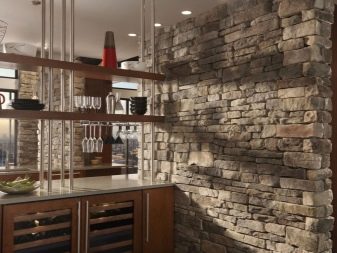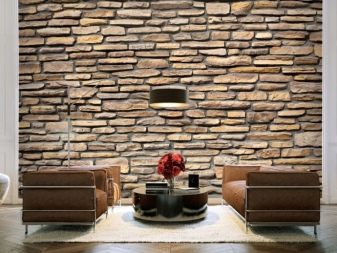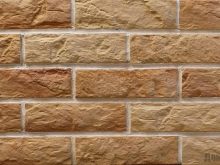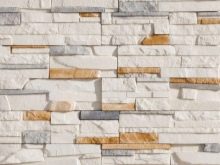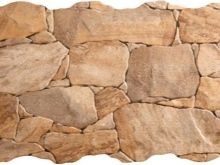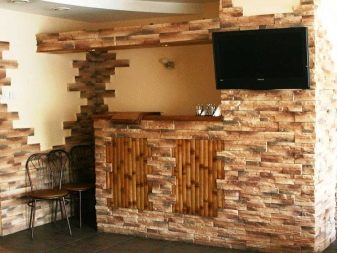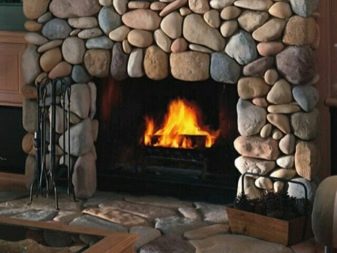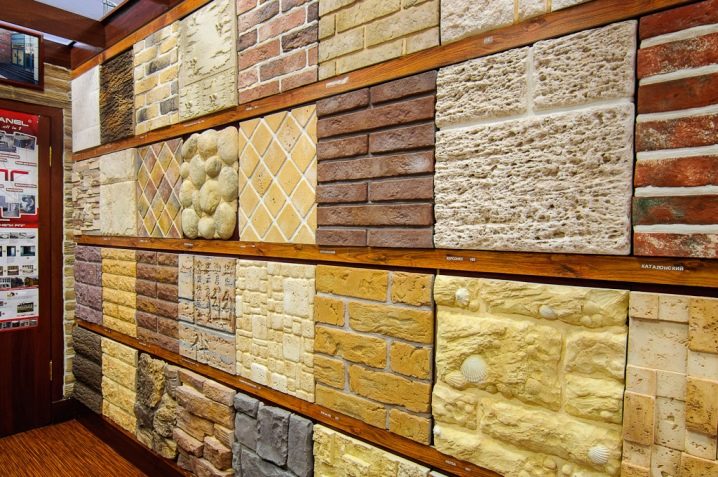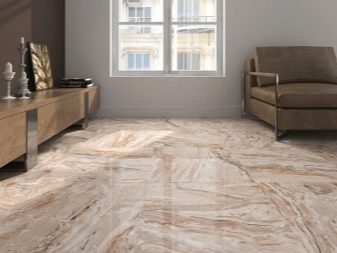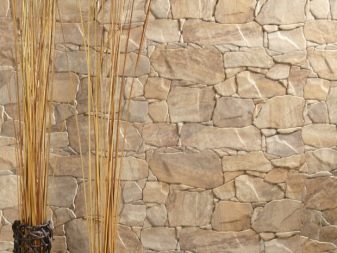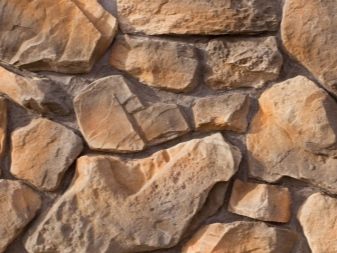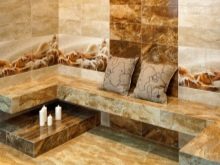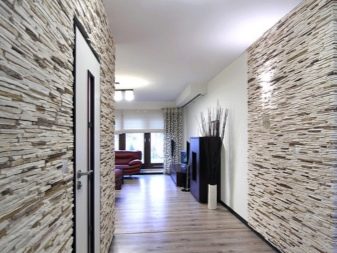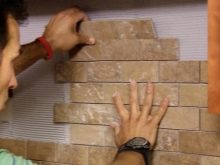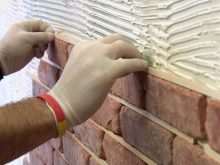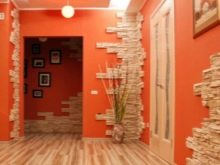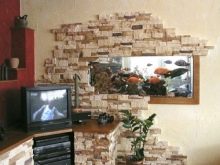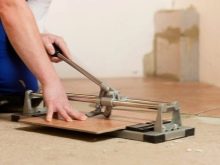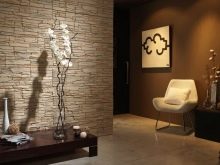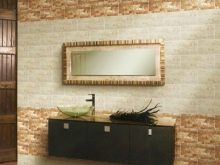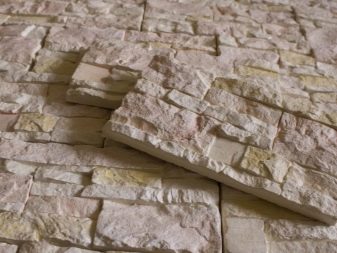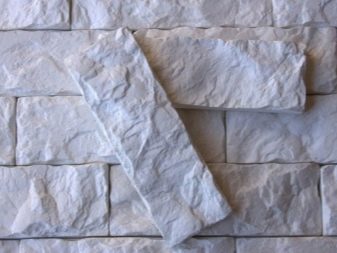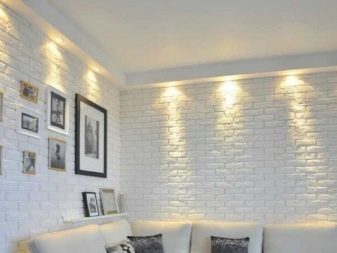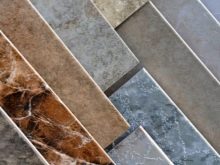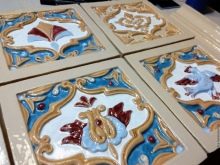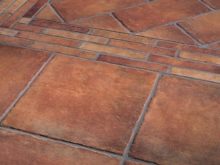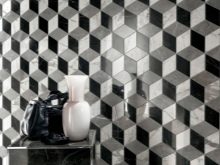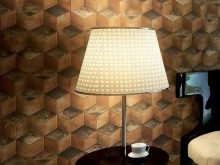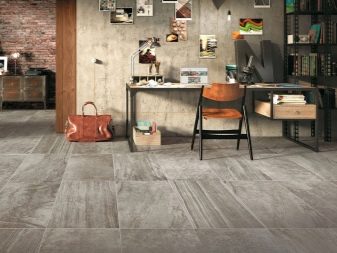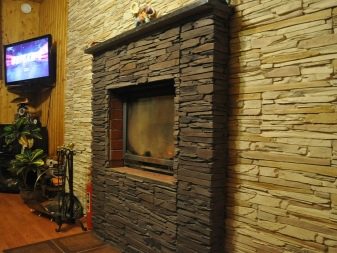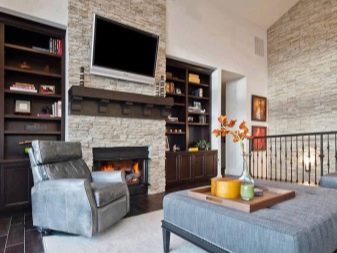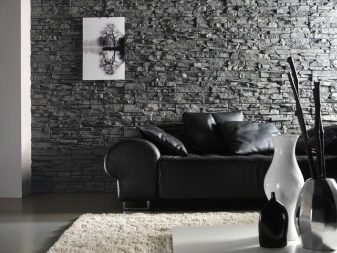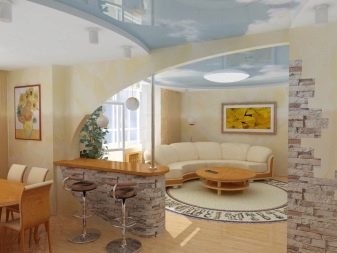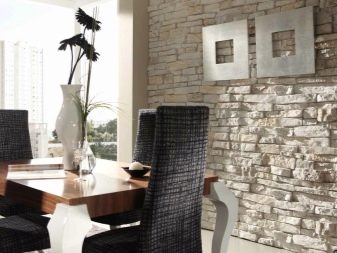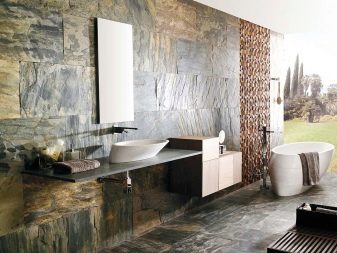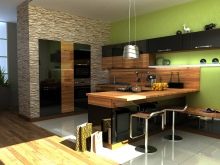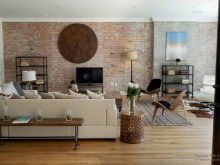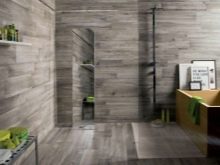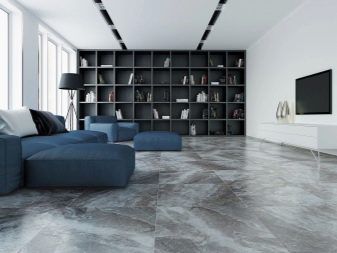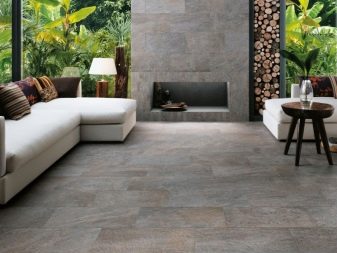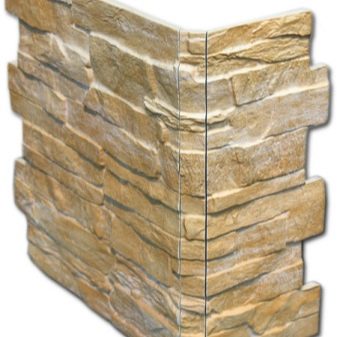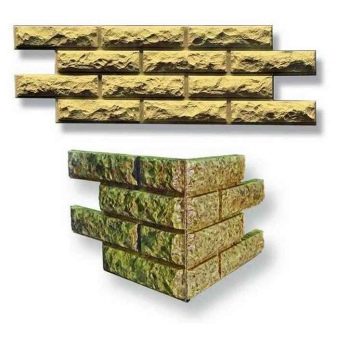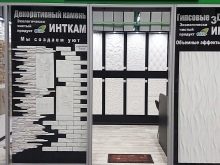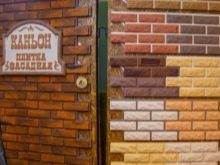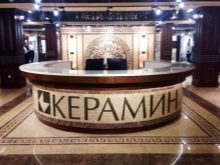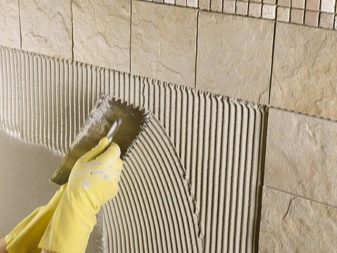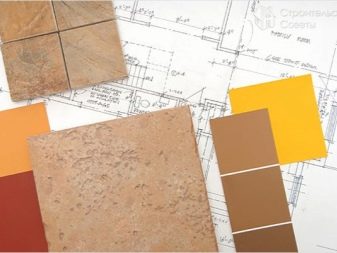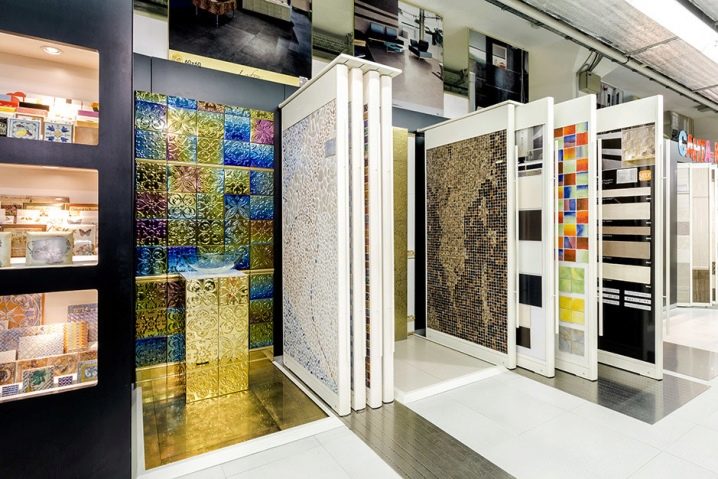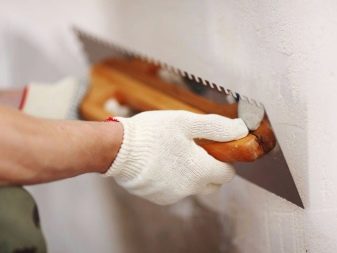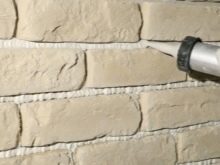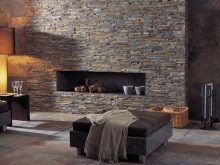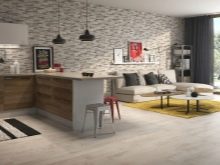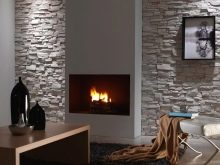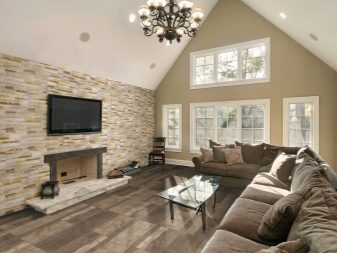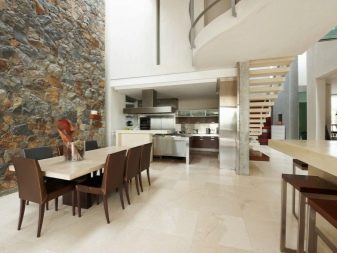Stone Tiles: Luxury Finish at a Bargain Price
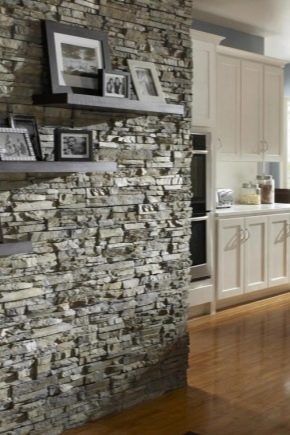
Choosing a finish that will give the interior uniqueness, many often prefer tile "under the stone." This technique allows you to arrange the accent walls of the home stylishly and fashionably. Such surfaces are distinguished by original texture, so that the basic idea of the design looks special. The secret of a unique tile "under a decorative stone" consists in invoice and appearance.
It is necessary to understand the intricacies of this facing, to study the features of luxurious finishes, the differences from the classic material, methods of application.
Special features
Tile "under the stone" is a luxurious kind of building material, which looks quite realistic imitates the texture of the stone. This is an imitation of this texture, intended primarily for decorating walls. Depending on the composition and method of production, the raw materials are different. It gives the surface a special relief, while reducing the width of the walls due to the thickness of each fragment, the dimensions of which are noticeably smaller when compared with classic tiles.
Externally, this tile is a small rectangular fragments.resembling a stone with uneven edges, while for the plausibility of the front side do different shading. Against the general background of the lining, the transitions of tones create the effect of versatility, which gives depth to the space, deprives the simplicity with obvious material roughness.
Each fragment may have a mass of irregularities. It is better if during the joining it turns out that the thickness of two adjacent fragments is different. This will give the surface originality.
The peculiarity of the decorative material is the method of laying, which is not correct in the classical sense.Tile under the stone does not need adjustment, it is not just imperfect. It is specially made different in size. Release it in two forms. In one case, it consists of a single fragment of a rectangular shape, characterized by a noticeable curvature of the relief.
Another type is a fragment consisting of several stones. This tile does not fit, as usual, with the formation of crosshairs. She has her own styling. Usually, a picture is made up of blanks by gluing fragments of different sizes, as closely as possible connecting the facing elements to each other.
Among the facings of each variety, you can find variants with smooth edges, as well as those whose edges are wavy. If the edges are even, then in some types of material it is noticeable. In this case, it is worth choosing fragments for decoration, the relief of which of the faces is greater in height. This will hide the seams.
Laying such material does not obey the geometry. The set often has a tile of different sizes, so that the work resembles a mosaic layout.
It is not necessary to measure out the middle of one fragment in order to glue another.This is convenient, although it makes it necessary to select every detail to make the look as attractive as possible. In the finished canvas, this diversity looks spectacular.
With or without relief?
A separate category of tiles "under the stone" is a type with a pattern. It does not convey the desired texture in the proper amount. Here, the emphasis is rather on shade and color. This is especially true of marble types of coatings. Nothing, except the type of marble surface and its coldness, is not to be expected from such a tile. The same can be said about the floor tile without relief. The picture, of course, can resemble stonework, the surface of natural stone, but it does not transmit imitation of relief.
The task of the tile "under the stone" with the relief is to replace the stone, and not a demonstration of the figure, so comparing two different materials is quite difficult. They are distinguished by the appearance, method of installation. So, fragments with imitation of the pattern of stone surfaces are close to the classical ceramic tile and porcelain stoneware. If we consider them from this point of view, then, apart from the external texture, there is little similarity. One tile resembles masonry, the other - the surface.The assignment of materials to one type is based on the fact that in both cases a stone is taken as the basis.
The variety with a pattern is distinguished by a smooth type of surface and strict geometric shapes. She has different sizes and colors. A distinctive feature is the variation of shades. So, often used shades of pastel. In fact, this is a common ceramic tile, the pattern of which is similar to a stone (for example, malachite, marble, wild stone).
It is easy to look after such tile: it is simpler to clean it. It is also possible to quickly carry out the installation, and if necessary - to dismantle it.
Benefits
The finishing tile imitating a decorative stone has a lot of advantages. The range of textures is quite extensive. So, she can reproduce the texture of natural granite, basalt, wild stone and many others. Compared with the natural counterpart, factory products are significantly cheaper (3-5 times). This allows for a luxurious surface finish, meeting the planned repair budget.
Such material is highly durable. Unlike wallpaper and ceiling tiles, it can’t be spoiled mechanically if you don’t do it on purpose.Such a surface, when preparing the base for quality, will decorate the walls of the dwelling for a long time without the need for adjustment.
This is especially true if the house has pets. They will not damage the facing surface.
This finish is durable. The material will hold on the surface of the prepared walls no less than ordinary tiles. The coating will get tired faster than moving away from the surface. Subject to the rules of laying it will last at least 20 years, and the shape and color of the fragments will not suffer even from dry cleaning. In addition, this material is not exposed to sunlight.
Such a laying is much easier than working with natural stone. Consumption of decorative tiles "under the stone" is 25-30 kg per 1 square. When laying natural material, each square meter of the wall will become visually “heavier” several times. With visual appeal, such an imitation will not allow the walls to settle or twist. This material differs in a variety of shades of a color palette and the used invoices. This significantly increases the possibilities of design, allows you to choose the accent place for such facing, so as not to overload the room with an abundance of small fragments.
Due to a rich choice there is an opportunity to enter this finishing in modern and ethnic stylistic directions.
A distinctive feature of wall tiles "under the stone" is the possibility of partial installation, which is not the case with other analogues. It can be laid out in the form of separate islands, peculiar patterns on the smoothly plastered surface of the base, not limited to the method of laying in the form of a single canvas. Through it you can carry out the finishing of adjacent planes, which gives the space a touch of antiquity.
When imitating destroyed walls, the effect of antiquity is created, which designers actively use.
disadvantages
Due to the unusual texture of this finishing material has several drawbacks, so the purchase can not be based solely on the attractiveness of appearance. To finish was really what you need, you should take into account its features. The problem may be variegated relief fragments. In the process of laying it is impossible to avoid cutting the material, which in this case is rather difficult.
The diamond glass cutter will not cope with the task, you will have to use powerful equipment (for example, a grinder).After pruning, it will take a long time to grind the cut so that it does not cause damage to the finished surface.
Despite the fact that this material strengthens the treated surface, it will not contribute to the maintenance of heat, since, regardless of the type of components, it is a cold material. It is unpleasant to lean on such a surface or simply touch it. For tactile sensations, she loses the same wallpaper and ceiling tiles. This lining does not provide for the location on the walls of any items or fixing furniture. The point is not the relief and complexity of installation, but unaesthetic crevices that will be visible to the eye.
A painting or a mirror on such a surface will look difficult. The same applies to furniture: its placement creates the feeling of being in a cave, which, in turn, will lead to a “weighting” of the space.
For the same reason, facing two walls or more is impossible. Even if you really want, the volume of the treated area can not be more than one wall. It looks ugly outwardly, overloads the interior composition, calls into question the relevance of the use of many items of furniture. Restrictions apply to textures.It is undesirable to use more than one - this will turn the relief into ordinary ripples.
Difficult and care for such material. It all depends on the composition of this tile. Not every type of lining withstands an abundance of moisture when cleaning. The problem is the relief. Unlike smooth tiles, which can be wiped with a damp cloth, the situation is different here. The dust accumulating on the surface will fill the areas of the depressions and the joints. Care is possible with a vacuum cleaner, but it will also be problematic. It will take a lot of time. Cleaning the surface with your hands can be traumatic.
Kinds
To date, decorative tiles "under the stone" on the construction market is represented by two varieties: plaster and ceramic. It is decorative and facade (for the decoration of the walls of facades). Each material has its own characteristics. Should consider the main aspects.
Gypsum
Tile "under the stone" of gypsum is a high-quality imitation of natural material. It is made from gypsum polymer mass, which has a low frost resistance, so this material can be used exclusively for interior work.It is light, hygroscopic - will absorb excess moisture and release it if the air is dry.
This tile is refractory and environmentally friendly, odorless, during operation will not fade under the influence of sunlight. Working with her is easy, but it requires accuracy. The disadvantage of this facing is fragility, therefore, it is impossible to prevent the appearance of chips before laying. At the end of the finishing works, the surface must be treated with a water-repellent coating, otherwise the tile may be deformed.
For this reason, it is not recommended for decoration of the walls of the bathroom and kitchen, although it is the place for it in the living room or the corridor.
Ceramic
This decoration is notable for the presence of several varieties. These include:
- ceramic granite;
- clinker;
- cotto;
- majolica.
Clinker released with and without glaze. It is suitable for cladding rooms of any type, so if you wish, you can even use it in the bathroom. Porcelain tile is characterized by zero moisture absorption and the absence of microcracks. Cotto is made from red clay. This species is characterized by a beautiful natural color. It is not coated with glaze, used in the hallway and lobby.Majolica has high quality characteristics.
Recently, under the stone "tile with 3D effect is gaining popularity. Externally, it looks volumetric due to the use of a special film that guarantees the three-dimensionality of the material. This material can have a relief or can be completely smooth. Especially realistic, it looks from afar, if it has a matte texture.
Location
This material can be used in different rooms of the home, if required by the design. However, there are spaces where it is inappropriate. This technique is not allowed in the toilet, when finishing the balcony, loggia and children's room.
With regards to the toilet and balcony ledges, the inadmissibility of the use is due to the fact that these spaces are already small in size. Look beautiful on their walls cladding "under the stone" will not.
The same can be said about the children's room. This decoration requires a certain style, and this style has nothing to do with children. She is good in the directions of loft, grunge, modern, brutalism.
Even with an open-plan apartment, this technique is irrelevant if the child lives in it:
- The finish is rough.It deprives the room of airiness, noticeably reduces the volume of the room. This is evident in the case of a spacious type of space reserved for the nursery.
- It is traumatic. In case of accidental fall, you can injure about imitation of stone material.
There are two options for a suitable space for such a space: an adult bedroom and a living room. In the first case, this technique is ideal for facing the zone at the head, in the second - there are a lot of techniques, among which the most harmonious look:
- finishing of a chimney ledge;
- decorating a niche for a video system;
- the allocation of the dining area when zoning;
- accent wall decoration guest space;
- wall decoration selectively with the imparting texture of destruction.
Using a tile in the form of a stone allows you to make a luxury in the design, while you can vary the layout of the tile. It can occupy part of the wall in the form of a monolithic canvas, be laid out in the form of a small ladder, imitate a ragged edge on a small part of the protrusion or two adjacent walls located perpendicular to each other.
In order for this decoration to look harmonious, it is not repeated everywhere, otherwise the technique is no longer expressive.
Color solutions
The color palette of the relief tiles for natural and artificial stone is diverse. In general, here adhere mainly to natural paints. One tone is undesirable. In the priority of multi-faceted color compositions. Sometimes you can see white and black in them, but more often you can find such combinations:
- gray + marsh + beige;
- beige + marsh + brown;
- sand + light gray + marble + black and gray;
- light gray + brick + beige + brown-red;
- light gray + beige + cold sand;
- marble gray + beige;
- dark wenge + terracotta + beige;
- light gray + dark gray + sand;
- brick + cold brown + light gray;
- yellow beige + gray + sand;
- warm beige + orange-brown + terracotta.
In addition to warm colors, the combination can be cold, but using only gray contrast with a black tone does not give the desired effect if a color companion is not added to them. The same beige makes the texture not boring. White color, diluting gloomy tones, makes them more pleasant for eyes. It allows you to give the tile the effect of versatility. Often the shade of a tile is complicated by the heterogeneity of contrasts.This gives greater similarity with the stone.
Sizes and shapes
Parameters and appearance of the relief tiles pasted on the walls are different. In addition to the basic rectangular shape, they can be arbitrarily square. In this case, the edges of these fragments abound in curly lines resembling refracted waves. For the convenience of lining distinguish regular and corner tiles. The dimensions of the first one are more often 24x7 cm, 24x14 cm, the angular variety in length can be 24 cm, in width - 12 or 14 cm. At the same time, a fragment of 15 cm comes around the corner.
The sizes are relative. Each brand adheres to its own standards, directly related to the features of the general web. Fragments can be traditional or very narrow. Often on sale you can find products 20x20 cm, 30x30 cm, 33x33 cm, 20x12 cm.
As for the varieties with the pattern, then everything is easier: their shape is rectangular or square, the size depends on the type of material and the country of the manufacturer.
- Wall cladding can have the parameters 10x10 cm, 15x15 cm, 20x25 cm, 25x45 cm, 20x30 cm, 25x30 cm, 25x35 cm, 25x40 cm, 20x50 cm, 30x30 cm.
- The parameters of the floor tile can be 15x15 cm, 20x20 cm, 20x30 cm, 30x30 cm, 40x40 cm, 45x45 cm, 50x50 cm.
- Porcelain stoneware has its own standards: 20x20 cm, 30x30 cm, 15x60 cm, 30x120 cm, 30x60 cm, 40x40 cm, 45x45 cm, 60x60 cm.
Manufacturers Overview
Today there are many companies engaged in the production of decorative tiles under the stone. It is worth noting the products of Italian and Spanish companies. This tile will make any dwelling special.
The most interesting samples include tiles of the following brands:
- "Canyon". Eco-friendly facade tiles, imitating stonework, resistant to temperature and humidity.
- Keramin. Material for interior decoration with a matte texture in a wide range, presented in white, beige, brick, sand, olive and gray.
- "Intkam". Manufacturer of tiles "under the wild stone" of plaster, performed in the noble and soft colors of the color palette.
- Kerama Marazzi. Reliable imitation of natural stone in each fragment.
Feedback on these materials is mostly positive. The buyer notes an interesting design, which allows you to create this cladding. Other advantages include durability. This finish looks beautiful, while it is durable.
What to consider when choosing?
Choosing facing material "under the stone", it is necessary to take into account several factors, ranging from appearance to technical characteristics. Initially, it is necessary to determine the type of planned work, because the tile for interior and exterior is completely different. It is impossible to apply to the facade of the variety, which is supposed to finish the inner walls. This tile will not last long.
- Consider the recommendations of the seller, choosing with the tile the right type of glue.
- Chipped material is unsuitable for work; if possible, everything should be viewed during the purchase process.
- When purchasing, it is necessary to add 10% of the material to the total quantity as a reserve (during operation, chips may appear, their formation during transportation is not excluded).
- Pay attention to the series number. This will minimize the diversity of the material to a minimum.
- Choosing material for finishing, pay attention to the room illumination. Gray and dark tones visually reduce the room, make it dark.
- Purchase in a reputable store with a good reputation. This will avoid buying a base counterfeit.
- Consider the features of the interior.If the furniture is dark, then it is preferable to buy a lining of light shades.
- It is not allowed to combine this material, even if there are varieties of identical tones on the counter.
- Pay attention to the price. Good goods are not cheap. In this case, it is an indicator of quality and durability.
Tips and tricks
In order for tile laying “under a stone” to be successful, and the finished result looked professional, it is not at all necessary to involve specialists in the decoration. This process is not cheap, but it can be done by every head of the family.
It is necessary to take into account several recommendations of experts who will help to understand how to work with this material:
- After the material is purchased and delivered home, you need a thorough inspection. Stone blocks inspect before the first batch of adhesive. It is important to assess the color uniformity, eliminate chipped. Nothing should interfere with quality work.
- The base must be prepared and durable. All cracks, irregularities, dirt from the surface are removed, then they are leveled with a gravel, ground. The soil will strengthen the walls, which will allow the cladding to hold firmly for a long time.
- When processing smooth surfaces it is worth picking up viscous glue. Work is performed in the direction from the corner. When working with conventional ceramic tiles, glue is applied to most of the wall. Working with small fragments, small portions of glue are applied to the wall.
- After the lining is finished, the gaps are rubbed with a special fugue, to which pigments are usually added to match the stone. This eliminates the appearance of joints. In the classic laying of tiles with a pattern, stitches are accentuated, choosing for this grout, a contrasting main finish.
In the work it is important to adhere to the same minimum distance. This will create a feeling of solidity. When laying a smooth tile with a pattern, it is important to immediately buy plastic crosses for the identity of the seams.
Beautiful examples in the interior
To see firsthand the possibility of decorating the space with tiles “under the stone”, you should pay attention to the examples presented in the photo gallery.
- Accent protrusion with a niche due to decorative tiles "under the stone" looks stylish. This design technique changes the perception of space.
- In an open-plan space, you can decorate the entire plane of the wall with tiles “under the stone”.It looks stylish, at the same time does not disturb the balance of the interior composition.
- Stylization of the dining area "under the natural stone" creates a special atmosphere. Such a technique in combination with beams on the ceiling is quite appropriate in the styles of loft or grunge.
- Beautiful and harmonious look in the living room decoration of the fireplace wall. At the same time, the fireplace projection itself does not have a lining.
- Partial decoration of the walls of the corridor or hallway is a stylish solution. It does not need a lot of decor, and the look of the lining will be special and fashionable.
- Unusual reception design of the protrusion-railing. The work is difficult, but the view is excellent. In part, this contributes to the different texture of surfaces and the lack of unnecessary decor in the room.
- Difficult, but successful example of location on the surface of the lining of the shelf and adjacent pedestals. Mandatory conditions - a minimum of relief and distraction through the bright strokes of the interior (in this case through the unusual furniture and wine-colored accessories).
- An example of a cozy dining room with fireplace and accent wall. Despite the complexity of placing the framework associated with the relief texture, the design is successful, it looks stylish. Fireplace creates a homely atmosphere.
- The decoration of the living room wall ceramics looks impressive. At the same time, the wall does not over tighten all the attention, leaving the dominant role to the fireplace.
- An example of an expressive accent is the selection of a chimney ledge. Facing does not violate the harmony of the interior, does not distract attention from the TV and fireplace. However, it would take a lot of effort to attach the plasma and the shelf like that.
- Highlighting the walls of a two-level house in the living area looks volume. The structure of the stone creates an unusual deep effect.
Features of the choice of tiles under the stone, see below.
